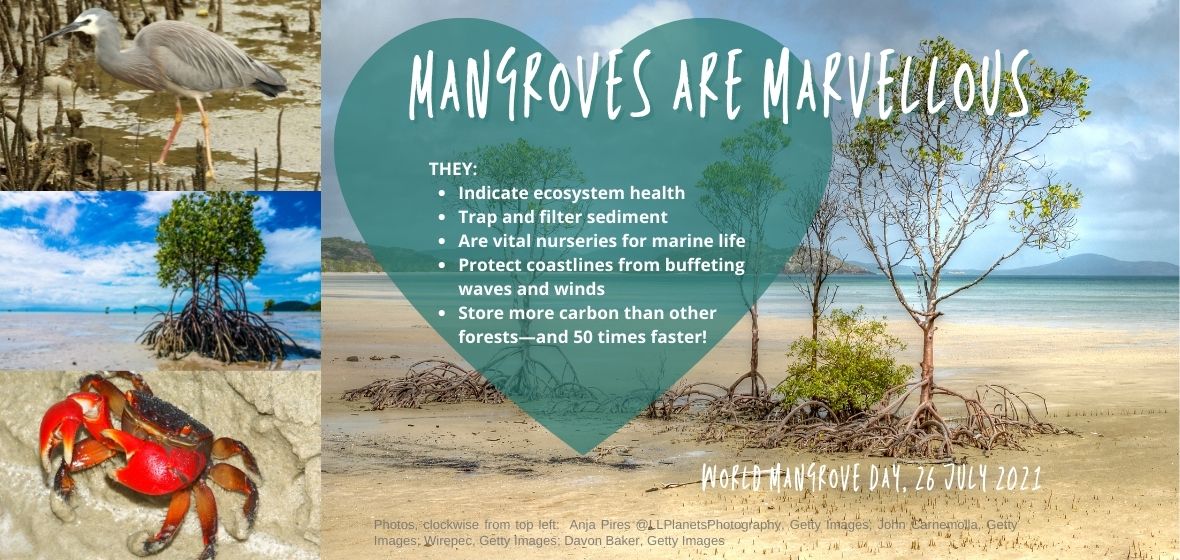26 July 2021
When you hear the word ‘forest’, you probably think of verdant rainforests, towering karri and jarrah, or the eucalyptus and lemon-scented gum of dry schlerophyll forest, right? Few of us realise that fringing our bays, rivers and tributaries are complex, biodiverse forest ecosystems that are vanishing 3–5 times more rapidly than all other global forests—MANGROVE FORESTS.
The International Day for the Conservation of Mangrove Ecosystems, observed annually on 26 July, helps raise awareness of mangroves as uniquely vulnerable ecosystems.
Audrey Azoulay, Director-General of UNESCO, said the day “serves as an opportunity to reflect on our personal commitment to climate and biodiversity conservation and promotes global action by all for a sustainable future.”
Mangroves play a vital role in our coastal ecosystems, and, as the ‘kidneys of our oceans’, they make an oversized contribution to our planet’s health by:
- filtering pollution, runoff and sediment, reducing erosion and protecting our tropical coral reefs
- buffering beaches and bays from the relentless oceans
- acting as nurseries for around 75 per cent of coastal fish and marine invertebrate species
- sequestering more carbon than any other ecosystem—just 1 hectare of mangroves stores as much carbon as taking 2,651 cars off the road each year!
Unfortunately, despite all that they do for us, the world’s forgotten mangrove habitats are in deep, deep muck!
Although fringing the land worldwide in 19 biospheres, they remain niche environments that comprise less than 0.4 per cent of the planet’s total forest estate. And in just forty years, global mangrove coverage has halved.
Australia’s mangroves habitats make up 7 per cent of the world’s total. They are the most southerly in the world and are incredibly biodiverse, including 58 per cent of known mangrove species and one endemic species, Avicennia integra. Sadly, over the past 200 years, some 17 per cent of our mangrove habitats have been degraded or destroyed.
What’s up with mangroves?
Often, they’re jostling for space on coastlines that are being ‘reclaimed’ (euphemistically) for development of housing, resorts, agriculture or maritime infrastructure. While little is being done to arrest the decline in mangrove forest distribution, they also face other threats, including:
- altered tidal flows or development around estuaries and rivers
- extreme weather events such as flooding, hail, or heavy rains
- invasive weeds
- leaf spot, blight and fungal disease
- trampling by stock or feral animals, especially in salt marshes
- damage from foot or vehicle traffic, particularly 4WD vehicle
- litter, dumping and oil spills
- pollution and fertiliser runoff causing excess nutrients and algal growth on mangrove roots
- mosquito control measures and insect infestations that defoliate leaves
- altered sea levels and ocean temperatures due to climate change.
Very special species
Mangroves require numerous special adaptations to survive the salt, mud and heat in their extreme environments. These specialists of the intertidal zone must tolerate being swamped by king tides and having their roots exposed at low tides. Some species have snorkel-like roots known as ‘pneumatophores’, which poke up from the thick mud to draw in oxygen. Others have buttressed roots that hold their trunks upright, and waxy, flange-like pores known as lenticels that draw in air while repelling water. Like desert plants, they must also limit evaporation, so special glands on their leaves secrete excess salt or move it about the plant.
Mangroves are skilled adapters, but they can’t survive the pressures they face without our help. We need to alter our way of living to better protect them.
MangroveWatch aims to help
MangroveWatch is a monitoring program devised by scientists Dr Norm Duke and Jock Mackenzie. It focuses on the health of estuaries, shorelines and waterways and advises on scientific and environmental management needs to encourage the protection of threatened tidal wetland ecosystems, especially mangrove and saltmarsh habitats.
A collaborative effort between citizen scientists and volunteers, traditional owners, government, industry and scientists, the project advocates for more sustainable management, shoreline rehabilitation and conservation of these uniquely beneficial plant and animal communities.
With the help of Wildlife Queensland Coastal Citizen Scientists, who have undertaken MangroveWatch in and around Moreton Bay for a number of years, we hope this World Mangrove Day raises awareness, stimulates discussion and finds solutions that will make a real difference in conserving these incredible habitats.
Make a difference and have fun
Wetlands and mangroves are the nurseries of our marine habitats, but they need our nurturing.
Educating yourself and others through resources and activities that increase our understanding of how our choices affect marine environments is the first step. You can learn more about these environments on a fun day out at Coochiemudlo Island Mangrove Festival on 31 July, download our World Mangrove Day colouring-in sheet, or consider a school or community-based project on mangroves, like Tajana Trotter and Paris Ormerod’s excellent 2011–2012 Cicada Award-winning film Mangroves.

